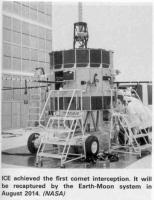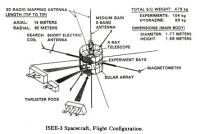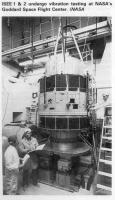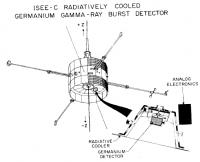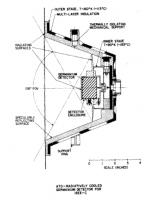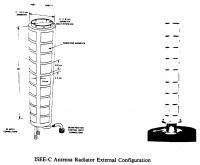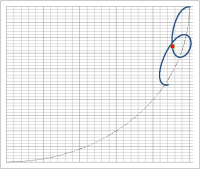Printable Version of Topic
Click here to view this topic in its original format
Unmanned Spaceflight.com _ Cometary and Asteroid Missions _ ICE / ISEE-3
Posted by: PhilCo126 Jan 24 2007, 06:43 PM
Any weblinks where we can learn something about the where-abouts of ICE/ISEE ( International Comet Explorer / International Sun Earth Explorer ) as the craft was expected to return to Earth in 2014?
Posted by: robspace54 Feb 16 2007, 05:17 PM
From the document below, which is a very long Word document. 37 pages and over 10 Mbytes in all.
highorbits.jhuapl.edu/aplmisns.doc
"Three delta-V maneuvers totaling 42 m/sec were performed in 1985 to target ICE to fly through the tail axis of Comet Giacobini Zinner about 8000 km from the nucleus. More details of the highly successful encounter are given elsewhere.
In 2014, ICE will pass near the Earth, and an in-plane delta-V of 1.5 m/sec and an out-of-plane delta-V of 39 m/sec were performed on February 27 and April 7, 1986, respectively, to target a lunar swingby on August 10, 2014.
That swingby plus some small maneuvers could capture ICE back into an Earth orbit, perhaps even returning it to a libration-point orbit14. ISEE-3/ICE may be known to most for its comet “first”, but in astronautics it is most famous for pioneering the use of both libration-point and double-lunar-swingby orbits."
Rob
Posted by: PhilCo126 Feb 14 2008, 08:01 PM
Indeed the multiple lunar flybys (5 in total in 1983) were needed to establish the transfer trajectory towards comet Giacobini-Zinner. (closest approach 7800 kilometers on 11th September 1985)
The spacecraft even flew 0.2 AU on the Sunward side of comet Halley on 28th March 1986.
Funny note: NASA has donated the spacecraft to the National Air & Space Museum if it could be captured/recovered during the Earth flyby in the year 2014 ![]()
Posted by: PhilCo126 Sep 19 2008, 03:44 PM
6 years to go before it comes close to Earth again ![]()
Posted by: elakdawalla Sep 20 2008, 02:09 AM
PhilCo or anybody else who has a collection of old journals: do any of you have the an issue of the Journal of the Astronautical Sciences from 2001, vol. 49, no. 1? I'm looking for an article "The flight of ISEE-3/ICE: Origins, mission history, and a legacy," specifically, figure 29...
--Emily
Posted by: ElkGroveDan Sep 20 2008, 02:54 AM
There are some ICEE orbital graphics here Emily (page 12 onward) if that's what you are looking for
http://www.ieec.fcr.es/libpoint/papers/dunham.pdf
Posted by: robspace54 Oct 10 2008, 02:09 PM
Here is a photo of ISEE-3 plus a diagram from the depths of the Internet. And for comparison a picture of ISEE-1.
Rob
Posted by: stevesliva Oct 10 2008, 03:07 PM
http://www.ieec.fcr.es/libpoint/papers/dunham.pdf
Figure 4 was very informative!
Posted by: robspace54 Oct 15 2008, 01:16 PM
This link is to a Time magazine article from long ago on ISEE-3 / ICE - first comet encounter by humans:
http://www.time.com/time/magazine/article/0,9171,959946,00.html
Interesting reading!
Rob
Posted by: jgoldader Jan 16 2009, 08:08 PM
Hello,
I'm starting a scratchbuild of ISEE-3/ICE in 1/24 scale. The images & other info posted here were a great start.
According to the press kit, the spacecraft sounds to be mostly hollow and open at the bottom side, with the exception of a cone-shaped structure that extends down from the instrument shelf (visible in top or oblique photos & drawings) to connect to the launch vehicle payload adapter. I'm visualizing something like the Pioneer Venus orbiter, where you could see all the way in from underneath.
Does anybody have a picture of the underside of ISEE-3/ICE to confirm this?
Thanks very much!
Jeff
Posted by: robspace54 Jan 20 2009, 07:46 PM
Jeff this is Rob (Yahoo - Space Modeler member). I'll see what I have at home, if the Internet is up there. We lost our modem over the weekend and it was to be repaired today. Have you checked the Files on the S-M website? There is a photo of ICE on the spin balance table that shows part of the lower structure.
Part 2 - I found this diagram of the gamma ray detector which is mounted on the aft end. The diagram shows no protruding structure. That kind of structure would block the -Z axis antenna. The diagram is from a data set report found on the internet.
Posted by: jgoldader Jan 20 2009, 09:59 PM
Part 2 - I found this diagram of the gamma ray detector which is mounted on the aft end. The diagram shows no protruding structure. That kind of structure would block the -Z axis antenna. The diagram is from a data set report found on the internet.
Rob,
Thanks very much for the diagram! I hadn't run into that one, and all of a sudden, this model got a lot easier! I do have the photo of ICE on the spin table, and between the two views, can make a reasonable go at the underside.
Also, I've sent a note to the ICE contact listed at NSSDC, in case he can provide any more information.
Shameless endorsement: For anyone reading this who has interest in modeling real spacecraft, the best resource I've found online is the Yahoo! space-modelers interest group Rob mentioned. Even if you don't care about modeling, thousands of imagses and drawings are in the archives--a lot of history is being preserved there.
Jeff
Posted by: robspace54 Jan 21 2009, 01:59 PM
Here is the ISEE 3 (ICE) S-band antenna - 4 inch diameter x 30 inches long
Posted by: djellison Sep 5 2012, 09:44 PM
So - time warp for a thread time but...
http://www.planetary.org/blogs/emily-lakdawalla/2008/1673.html
In that awesome article, Emily mentioned that it would need to be reactivated in 2012 for a 2014 recapture.
Any news on that? I've heard nothing.
Posted by: tedstryk Sep 8 2012, 02:18 AM
http://www.planetary.org/blogs/emily-lakdawalla/2008/1673.html
In that awesome article, Emily mentioned that it would need to be reactivated in 2012 for a 2014 recapture.
Any news on that? I've heard nothing.
I've done a lot of searching on this and come up dry.
Posted by: bobik Nov 5 2012, 06:28 PM
http://www.agu.org/journals/sw/swa/opinion/article/?id=2012SW000832 (15 August 2012)
Posted by: elakdawalla Nov 5 2012, 06:52 PM
I actually talked with Farquhar about this a couple of months ago. I got no news from the conversation though. They're still working on it; there's no update on specific future plans. I can ask around but don't think there'd be much point right now. If I haven't heard anything new before August 2013, I'll begin pestering people then.
Posted by: Paolo Apr 14 2013, 10:07 AM
I stumbled upon this conference at the BIS by Robert Farquhar: http://www.bis-space.com/2012/11/29/7813/bis-prestige-lecture-teaching-old-spacecraft-new-tricks
any info on this?
Posted by: Paolo Apr 28 2013, 12:43 PM
watch out for this paper to be presented at this year's IAF congress in September
http://www.iafastro.net/iac/paper/id/16371/summary.lite/
Posted by: brellis Apr 29 2013, 12:30 AM
Emily is the pesterer-in-chief!
Posted by: Doug M. Jan 22 2014, 08:50 AM
Has anyone ever heard anything further on this?
Doug M.
Posted by: Paolo Jan 22 2014, 09:51 AM
last times I heard about ICE are these two blog posts by Emily:
http://www.planetary.org/blogs/emily-lakdawalla/2013/09181511-ice-is-returning-to-earth.html
http://www.planetary.org/blogs/emily-lakdawalla/2013/20131231-whats-up-in-planetary-2014.html
Posted by: elakdawalla Jan 22 2014, 03:40 PM
I haven't heard anything since then.
Posted by: Paolo Feb 5 2014, 06:19 AM
there was a sad update this morning on the https://www.facebook.com/ISEE3returns
The transmitters of the Deep Space Network, the hardware to send signals out to the fleet of NASA spacecraft in deep space, no longer includes the equipment needed to talk to ISEE-3. These old-fashioned transmitters were removed in 1999. Could new transmitters be built? Yes, but it would be at a price no one is willing to spend. And we need to use the DSN because no other network of antennas in the US has the sensitivity to detect and transmit signals to the spacecraft at such a distance.
This effort has always been risky with a low probability of success and a near-zero budget. It is thanks to a small and dedicated group of scientists and engineers that we were able to get as far as we have. Thank you all very much.
Posted by: mcaplinger Feb 8 2014, 05:14 PM
Given all the negative comments this is producing on the web, whoever is writing this stuff would be well-served to give more technical detail. I found http://ipnpr.jpl.nasa.gov/progress_report/42-76/76K.PDF which indicates that ICEE-3 was never designed to use the DSN for communications and a special filter had to be added to the Block V masers at DSS-14 and DSS-63 in the mid-80s to communicate with it. According to http://deepspace.jpl.nasa.gov/dsndocs/810-005/101/101E.pdf the maser was replaced at DSS-14 (Goldstone) in 2010 but the one at DSS-63 (Madrid) isn't going to be until this November, but S-band uplink isn't supported at Madrid because of frequency conflicts.
Posted by: Paolo Feb 8 2014, 05:55 PM
speaking of which, radio hams wanting to try to receive the carrier from the probe can find infos on the communication system http://mdkenny.customer.netspace.net.au/ISEE-3.pdf and http://ipnpr.jpl.nasa.gov/progress_report/42-84/84title.htm (scroll to the section on ICE).
orbital data are much more difficult to find and ICE is not on JPL's Horizon. There are daily heliocentric ephemeris up to 1997 ftp://nssdcftp.gsfc.nasa.gov/spacecraft_data/isee/isee3/traj/daily/ and lots of old orbital data http://pdssbn.astro.umd.edu/holdings/ice-c-mag-3-rdr-giacobin-zin-v1.0/geometry/. Unfortunately, the latter date from before the sizeable 1986 maneuvers (see http://ipnpr.jpl.nasa.gov/progress_report/42-86/86CC.PDF for info), So they are probably useless, even if you had a good orbit propagator to take into account all perturbations (including solar radiation pressure that must be non negligeable for such a small spacecraft).
Posted by: mcaplinger Feb 21 2014, 07:46 PM
It's worth noting that http://www.r00t.cz/Sats/Grail was able to decode the Grail signal all the way to the actual strings in a spacecraft directory listing, which is quite impressive. I think commanding ISEE-3 is likely out of reach, but decoding the telemetry might at least be possible for these folks.
Posted by: Paolo Feb 21 2014, 09:51 PM
as far as I know the transmitter on ICE is only beaming a carrier wave, so there is no telemetry to be decoded
Posted by: Explorer1 Mar 3 2014, 08:04 AM
xkcd hits a home run again!![]()
http://xkcd.com/1337/
Posted by: mcaplinger Mar 3 2014, 09:48 PM
I guess I'm a little surprised that http://en.wikipedia.org/wiki/Hackers_%28film%29 is still in the zeitgeist.
Posted by: Paolo Mar 9 2014, 04:13 PM
it's still alive!!!
http://amsat-uk.org/2014/03/09/radio-amateurs-receive-nasa-isee-3ice-spacecraft/
such a waste...
Posted by: bobik Mar 11 2014, 07:38 PM
They say, "In light of the recent observations and the available facilities in Bochum, additional studies about the economic feasibility to add a suitable uplink are being done." Unfortunately, I think this comes a little too late. Why didn't AMSAT-DL got active years earlier? Didn't they know of this opportunity?
Posted by: Paolo Mar 12 2014, 07:49 AM
note that ICE has finally been added to JPL's Horizon spacecraft database
http://ssd.jpl.nasa.gov/horizons.cgi#top
Posted by: Paolo Mar 12 2014, 01:04 PM
A plot of the trajectory of ICE from January 2013 until 11 August 2014, with the Earth fixed at 1,0. The red square is the position of the probe today.
From the JPL Horizon data, the closest approach will be on 9 August at 11.44 UTC at about 404,000 km.
Posted by: Paolo Mar 19 2014, 10:05 AM
hope is not lost... http://www.npr.org/2014/03/18/289628696/space-thief-or-hero-one-mans-quest-to-reawaken-an-old-friend
Posted by: stevesliva Mar 19 2014, 07:35 PM
Great article, thanks. It's amazing (to me) that I can read the thing and think, "oh yeah, 1978 launch, clearly amazing/impossible/jawdropping." And then I recall that the Voyagers were launched in 1977, though they are RTG powered. I can't seem to find the longevity record for solar power.
Posted by: stone Mar 19 2014, 08:18 PM
There are some people in Germany try to get in contact with ICE.
http://www.spiegel.de/wissenschaft/weltall/kometenjaeger-ice-amsat-funkamateure-wollen-sonde-einfangen-a-958189.html
Posted by: Gerald Mar 20 2014, 09:56 AM
The article contains links to some technical documents of ISSE-3/ICE:
- http://mdkenny.customer.netspace.net.au/ISEE-3.pdf (with a list of web links)
- http://ntrs.nasa.gov/archive/nasa/casi.ntrs.nasa.gov/19920003890.pdf
- http://ipnpr.jpl.nasa.gov/progress_report/42-76/76K.PDF
Quite a way to go from receiving a signal to commanding a probe in the correct language.
Hopefully the teams will together be able to build kind of backup DSN for ISSE-3/ICE.
Posted by: tedstryk Apr 15 2014, 09:51 AM
Apparently an attempt is being made. http://www.rockethub.com/projects/42228-isee-3-reboot-project-by-space-college-skycorp-and-spaceref#description-tab
Posted by: Gerald Apr 15 2014, 01:43 PM
http://www.rockethub.com/projects/42228-isee-3-reboot-project-by-space-college-skycorp-and-spaceref#description-tab.
[Edit: Link is fixed now in the post above, thanks!]
Posted by: tedstryk Apr 15 2014, 09:53 PM
[Edit: Link is fixed now in the post above, thanks!]
I have contributed, although it is a longshot. It would be a great story.
Posted by: Xcalibrator May 16 2014, 03:14 PM
Latest news at http://spacecollege.org/isee3/isee-3-reboot-project-status-and-schedule-for-first-contact.html. Sounds like they're making good progress, considering the challenge.
Posted by: tedstryk May 16 2014, 11:57 PM
They've now exceeded theirhttp://www.rockethub.com/projects/42228-isee-3-reboot-project-by-space-college-skycorp-and-spaceref, which is a good sign.
Posted by: Explorer1 May 21 2014, 05:28 AM
http://spacecollege.org/isee3/isee-3-reboot-project-hardware-detects-isee-3-at-arecibo.html
Posted by: mcaplinger May 21 2014, 06:10 AM
Note that this was simply a detection, something that was done by other groups back in March. If they transmit and get a response, then that will be news.
Posted by: djellison May 21 2014, 04:12 PM
Indeed - the AmSat DL team at Bochum with their 20m dish that's just 1/15th the diameter of Arecibo received a signal almost 2 months ago
http://amsat-uk.org/tag/bochum/
Posted by: Mongo May 23 2014, 03:26 PM
A minor update: a comment today to http://www.centauri-dreams.org/?p=30681#comments about the recontact attempt.
Posted by: Paolo May 24 2014, 06:06 PM
from an email just sent to supporters:
Posted by: mcaplinger May 24 2014, 06:57 PM
One wonders how much of this is a real concern and how much an attempt to increase drama. The latter would be understandable but I look forward to the technical details.
Posted by: Explorer1 May 24 2014, 07:45 PM
http://spacecollege.org/isee3/isee-3-reboot-project-updates-from-the-front-at-arecibo-by-dennis-wingo.html
First commands may be sent as early as Tuesday....
Posted by: Phil Stooke May 26 2014, 08:27 PM
So... the lunar flyby was supposed to be very low altitude, and the current uncertainty means the spacecraft might impact. "This has become extremely important as there is a solid statistical chance that the spacecraft could impact the moon or even be off course enough to threaten other spacecraft in Earth orbit."
(http://nasawatch.com/archives/2014/05/isee-3-is-not-e.html)
Is it inappropriate of me to wish for an impact so I can mark it on my map? Not even if I said it was to save those other spacecraft?
Phil
Posted by: mcaplinger May 26 2014, 09:13 PM
The stated error is 250e3 km, presumably derived from RA/dec errors in pointing since they don't have any range data. Unless there's some data they haven't described, they really know very little about the actual positional error, and prognosticating impacts or approach distances is nearly meaningless at this point. They need ranging, and for that they have to command the spacecraft AFAIK.
Posted by: nprev May 26 2014, 09:45 PM
"...off course enough to threaten other spacecraft in Earth orbit..."
Oh, come ON. That's off-scale unlikely & quite unnecessarily dramatic. My odds of winning the lottery three times in a row are probably better than ISEE-3 colliding with an Earth-orbiting spacecraft.
Posted by: djellison May 27 2014, 12:25 AM
Agreed - it's a laughable suggestion.
Posted by: mcaplinger May 27 2014, 02:26 PM
Laughable probably isn't quite fair. For example, a lot of effort was spent on collision avoidance for the Juno flyby, a lot more than you might expect statistics to justify. But given the lack of knowledge of the trajectory, it's certainly premature to worry.
Now they're saying that they are waiting for NASA approval to transmit (which seems odd). I don't know if they have to explicitly command to get ranging or if the spacecraft will transpond just with an uplink carrier.
http://trs-new.jpl.nasa.gov/dspace/bitstream/2014/40972/1/07-0166.pdf is a good reference for how ranging works. I don't know if they have access to the needed ground hardware or if they can fake it with SDR or if this is one of the things they're trying to pay for the DSN to do.
As an aside, orbit determination could be done without any ranging data (Gauss managed it in 1801 after all, see http://www.schillerinstitute.org/fid_97-01/982_orbit_ceres.pdf ) but I suspect that this would not be accurate enough to support their navigation goals.
Posted by: djellison May 27 2014, 02:51 PM
Yes - but Juno was coming to within a few hundred km of Earth - thru the shell of comm HEO, MEO, LEO spacecraft - thousands and thousands of active and tens of thousands of deceased bits of hardware. That is deserving
ISEE-3 with possible lunar flyby or lunar impact? Using words like "threaten other spacecraft in Earth orbit" - that's laughable. There's as much chance as a random asteroid taking out an earth orbiting spacecraft
Posted by: ElkGroveDan May 28 2014, 02:20 AM
Good point Doug. It sounds like a bunch of self-serving hype if you ask me.
Posted by: Paolo May 29 2014, 03:59 PM
according to the latest tweet by the ISEE3 Reboot Project
according to JPL's horizons, ISEE-3/ICE will be close to the zenith at Arecibo around 19.45 UTC
Posted by: Explorer1 May 29 2014, 08:01 PM
http://spacecollege.org/isee3/we-are-now-in-command-of-the-isee-3-spacecraft.html
Posted by: Paolo May 29 2014, 08:01 PM
SUCCESS!!! http://spacecollege.org/isee3/we-are-now-in-command-of-the-isee-3-spacecraft.html
Posted by: mcaplinger May 29 2014, 09:24 PM
Good news, but I wish they said exactly what they have done. Sending command bits and getting a change in the spacecraft state would be more encouraging than sending an unmodulated uplink carrier and getting transponding, but both could plausibly be called "two-way communication."
Posted by: gpurcell May 30 2014, 01:31 AM
Is receiving telemetry the same as getting transponding?
Posted by: mcaplinger May 30 2014, 02:21 AM
No; transponding is just getting a phase-coherent copy of the uplink carrier back on the downlink without modulation. But based on the last updates to http://spacecollege.org/isee3/ they have succeeded in commanding the s/c to send modulated data. Still not clear what if anything is being sent, but this is definitely very encouraging.
Posted by: ElkGroveDan May 30 2014, 04:28 AM
It's good news, but the people handling the PR and social media are behaving like rank amateurs. The hype at this point that the ICE / ISEE-3 team are churning out is really premature and they are setting themselves up for a media feeding frenzy if everything doesn't go exactly as planned. I get the sense that there are one or more huge egos driving this rather than the cooler heads we typically encounter with NASA professionals.
Posted by: mcaplinger May 30 2014, 04:45 AM
On the contrary, my sense is that the media loves the underdog spin and even if they don't do anything else they'll be viewed as heroes for having tried on their "shoestring budget."
I can appreciate that the tone of what they write is a bit grating, but I propose we treat them with rule 2.6 in mind as much as possible.
Posted by: bobik May 30 2014, 05:37 AM
Could anyone please explain this http://spacecollege.org/isee3/isee-3-spacecraft-status.html to me? It sounds like a paradox: We have successfully commanded both of ISEE-3's data multiplexers into engineering telemetry mode. The current bitrate is 512 bits/sec. … When we are confident of the state of the spacecraft, we will be placing the bird in engineering telemetry mode as soon as possible.
Posted by: mcaplinger May 30 2014, 05:52 AM
Either it's poorly worded and the spacecraft is already in engineering mode, or it's possible to set the multiplexers to produce a modulated data stream but not pull actual data from sources on the spacecraft. In the latter case one presumes the data being sent would be fill or garbage. I haven't found any information that describes the ISEE systems in enough detail to know for sure. http://nssdc.gsfc.nasa.gov/nmc/spacecraftTelemetry.do?id=1978-079A has a little but not much.
Posted by: stevesliva May 31 2014, 05:22 AM
I disagree. It's all in good fun, and I actually don't think there's too many chance of headlines like "$15 million** NASA probe DIES," because hey, even the media can figure out this thing's old. There's really no downside. (** Or whatever... what did this thing cost to make in the mid-70s?)
*My* cynicism is... there's probably not much practical reason to do any of this. But I still think it's neat.
Posted by: nprev May 31 2014, 09:27 AM
I just hope that they don't try any truly absurd grandstanding. That ridiculous statement about ISEE-3 possibly colliding with Earth-orbiting sats still really sticks in my craw.
The right thing to do here would be to use this exercise as an EPO tool to inform people about the very interesting & too often unappreciated field of spacecraft command & control. I'd honestly love to read a book about their efforts when it's all over. But if they or some individual(s) among them try to portray their efforts as anything but doing something very cool for the sheer fun of it that'll definitely cross a line.
Posted by: Paolo May 31 2014, 09:47 AM
as http://www.skyandtelescope.com/astronomy-news/35-year-old-isee-3-spacecraft-phones-home/ reminds
Posted by: djellison Jun 2 2014, 02:11 AM
At last a nice blog post full of details about exactly what they've managed to do so far!
http://spacecollege.org/isee3/isee-3-reboot-project-update-bullseye-and-more.html
Looks like they'll need only 5.8m/sec to divert onto the appropriate lunar flyby trajectory.
Posted by: nprev Jun 2 2014, 04:11 AM
Hats off to them! Fascinating work, and remarkable that the trajectory of the spacecraft remained so stable!
Posted by: stevesliva Jun 2 2014, 04:31 AM
If they do the TCM by June 17.
I hope they nail it!
Posted by: climber Jun 3 2014, 08:38 PM
More news from the source pointed out by Doug.
>ISEE-3 Mission Status 3 June 2014
Telemetry we have received from ISEE-3 shows that it is spinning at 19.16 rpm. The mission specification is 19.75 +/- 0.2 rpm. We have also learned that the spacecraft's attitude relative to the ecliptic is 90.71 degrees - the specification is 90 +/- 1.5 degrees. In addition, we are now receiving information from the spacecraft'shttp://nssdc.gsfc.nasa.gov/nmc/experimentDisplay.do?id=1978-079A-02.
Posted by: stevesliva Jun 7 2014, 09:58 PM
For those who were wondering what the small body radar images mentioned in an ISEE update were, here they are:
http://www.usra.edu/news/pr/2014/comet209PLINEAR/
Fairly fitting that it's a comet.
Posted by: Mongo Jun 17 2014, 11:27 PM
http://spacecollege.org/isee3/isee-3-status-report-16-june-2014-afternoon.html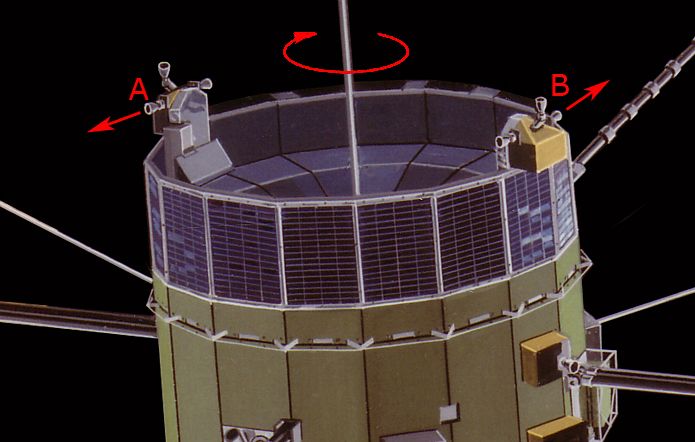
We have a very strong confirmation (correct number of commands accepted) that transponder A is in coherent ranging mode and we have reasonably strong confirmation that transponder B is also in coherent ranging mode. We are now set up and ready to go for our first ranging session with DSN on 18 June. Our first session will use DSS-24, a 34 meter dish with 20kW transmitter located at Goldstone in California.
If this ranging session with DSN is successful then we will proceed with plans to briefly fire two of the spacecraft's thrusters on 21 June so as to spin it up from 19.16 rpm to the mission specification of 19.75 +/- 0.2 rpm.
Our spin-up target is 19.733 rpm, which is an increase of 0.573 rpm from the currently observed 19.16 rpm. This burn would utilize spin-up thrusters A and B (see image above) at a 22.5 degree pulse-width. There would be 11 pulses, taking 34 seconds to complete, with a total fuel usage of 0.0418 pounds.
This optimal spin rate is required in order to properly fire the axial thrusters during the much longer trajectory correction maneuver (TCM) we need to perform to adjust the spacecraft's course. That TCM burn is now scheduled to happen between 30 June and 2 July.
Posted by: djellison Jun 18 2014, 12:08 AM
ISEE3 should show up as ICE on DSN Now at http://eyes.nasa.gov/dsn
Currently it's scheduled from 1945 UTC tomorrow with 100 minutes of setup time. It may be 2045 until we therefore see a signal - but it might be earlier than that.
Posted by: anticitizen2 Jun 18 2014, 08:08 PM
DSN activity!
http://i.imgur.com/MZtaG69.jpg
Edit: Didn't notice the ISEE3Reboot twitter, which was covering this with more detail - https://twitter.com/ISEE3Reboot
"@ISEE3Reboot: We think DSN comms issue has to do w/ #ISEE3 transmitter old age habits - it tends to fall out of ranging mode after a while. Easy to fix."
Posted by: Mongo Jun 20 2014, 01:33 AM
http://spacecollege.org/isee3/isee-3-status-report-19-june-2014-afternoon.html
In the mean time, due to some pulsar observations that need to be conducted at Arecibo, we have moved up our ISEE-3 Spin-up burn to tomorrow, Friday 20 June. Our window at Arecibo opens around 1:18 pm EDT. We'll be performing the burn during the following several hours.
Posted by: Mongo Jun 20 2014, 06:44 PM
https://twitter.com/ISEE3Reboot
ISEE3 Reboot Project @ISEE3Reboot 18m
Now sending dummy command to find receiver's sweet spot.
ISEE3 Reboot Project @ISEE3Reboot 13m
Command counter incremented 21 out of 21 times from +5 kHz to 25 kHz.
ISEE3 Reboot Project @ISEE3Reboot 7m
We're going to have to scrub #ISEE3 spin-up burn for today. Can't confirm receipt of commands in real time by the spacecraft.
ISEE3 Reboot Project @ISEE3Reboot 7m
If we cannot confirm that proper commands were sent to propulsion system we cannot fire thrusters with full confidence
ISEE3 Reboot Project @ISEE3Reboot 5m
Real time telemetry is not working as expected on #ISEE3 today. Remember: this spacecraft does not have a computer.
ISEE3 Reboot Project @ISEE3Reboot 2m
All 21 dummy commands worked - that should NOT have happened. Next time we sent them only 3 were accepted. Investigating ...
Posted by: Mongo Jun 20 2014, 07:29 PM
ISEE3 Reboot Project @ISEE3Reboot 33m
Next #ISEE3 spin-up burn attempt will likely be the middle of next week - after our next DSN session.
SEE3 Reboot Project @ISEE3Reboot 15m
We're still talking to #ISEE3 right now.
Posted by: Mongo Jun 29 2014, 01:25 AM
I thought I would list the most important posts from the ISEE-3 Reboot Project, in chronological order.
http://spacecollege.org/isee3/isee-3-reference/isee-3-data-collections.html
January 29, 2014 10:53 AM
http://spacecollege.org/isee3/isee-3-reference/isee-3-trajectory-information.html
January 30, 2014 10:48 AM
http://spacecollege.org/isee3/isee-3-reference/isee-3-experiment-summary.html
January 31, 2014 9:01 AM
http://spacecollege.org/isee3/isee-3-reference/isee-3-telemetry-systems.html
January 31, 2014 10:56 AM
http://spacecollege.org/isee3/isee-3.html
April 14, 2014 11:00 AM
http://spacecollege.org/isee3/isee-3-reboot-project-technical-update-1-may-2014.html
May 1, 2014 5:21 PM
A lengthy post summarizing the technical issues facing the Reboot Project at its start.
http://spacecollege.org/isee3/isee-3-reboot-project-near-term-objectives.html
May 5, 2014 10:17 AM
Another fairly lengthy post going into more detail about what steps needed to be taken to restore the ISEE-3 spacecraft to normal operations.
http://spacecollege.org/isee3/isee-3-reboot-project-status-and-schedule-for-first-contact.html
May 15, 2014 11:37 AM
An overview of the assets in place and expected, for contacting the spacecraft.
http://ISEE-3%20Reboot%20Project%20Hardware%20Detects%20ISEE-3%20at%20Arecibo
May 19, 2014 11:19 PM
http://spacecollege.org/isee3/stronger-signal-at-arecibo.html
May 22, 2014 5:56 PM
http://spacecollege.org/isee3/isee-3-reboot-amplifier-installed-at-arecibo.html
May 23, 2014 7:37 PM
http://spacecollege.org/isee3/isee-3-reboot-project-updates-from-the-front-at-arecibo-by-dennis-wingo.html
May 25, 2014 6:02 PM
Overview of previous week's activities at Arecibo.
http://spacecollege.org/isee3/we-are-now-capable-of-making-first-contact.html
May 26, 2014 8:11 PM
http://spacecollege.org/isee3/we-are-now-in-command-of-the-isee-3-spacecraft.html
May 29, 2014 4:07 PM
http://spacecollege.org/isee3/isee-3-spacecraft-status.html
May 29, 2014 6:35 PM
http://spacecollege.org/isee3/confirmation-that-isee-3-is-transmitting-telemetry.html
May 29, 2014 8:11 PM
http://spacecollege.org/isee3/isee-3-mission-control.html
May 30, 2014 8:29 PM
http://spacecollege.org/isee3/isee-3-reboot-project-update-bullseye-and-more.html
June 1, 2014 7:14 PM
Good summary of ISEE-3's status, including first telemety received from the spacecraft.
http://spacecollege.org/isee3/nasaisee-3-reboot-project-space-act-agreement.html
June 3, 2014 10:42 AM
Text of the agreement with NASA.
http://spacecollege.org/isee3/isee-3-mission-status-3-june-2014.html
June 3, 2014 2:01 PM
http://spacecollege.org/isee3/isee-3-status-report-5-june-2014.html
June 5, 2014 11:42 AM
http://spacecollege.org/isee3/isee-3-status-report-5-june-2014-afternoon.html
June 5, 2014 3:59 PM
http://spacecollege.org/isee3/isee-3-status-report-6-june-2014-afternoon.html
June 6, 2014 4:49 PM
http://spacecollege.org/isee3/images/what-isee-3-really-looks-like.html
June 7, 2014 11:36 AM
http://spacecollege.org/isee3/isee-3-status-report-9-june-2014-afternoon.html
June 9, 2014 11:45 PM
http://spacecollege.org/isee3/isee-3-science-instrument-update-12-june-2014.html
June 12, 2014 4:40 PM
http://spacecollege.org/isee3/isee-3-reboot-project-scheduled-for-dsn-ranging-activity.html
June 13, 2014 9:42 AM
http://spacecollege.org/isee3/isee-3-status-report-13-june-2014.html
June 13, 2014 10:21 PM
http://spacecollege.org/isee3/isee-3-propulsion-system-overview.html
June 14, 2014 10:14 AM
Detailed overview of ISEE-3 propulsion system.
http://spacecollege.org/isee3/isee-3-status-report-16-june-2014-afternoon.html
June 16, 2014 5:55 PM
http://spacecollege.org/isee3/isee-3-status-report-19-june-2014-afternoon.html
June 19, 2014 8:36 PM
http://spacecollege.org/isee3/isee-3-status-report-20-june-2014-afternoon.html
June 20, 2014 3:22 PM
http://spacecollege.org/isee3/isee-3-status-report-23-june-2014-dsn-ranging-update.html
June 23, 2014 9:26 AM
Fairly detailed analysis of command uplink failure.
http://spacecollege.org/isee3/isee-3-status-24-june-2014-we-almost-did-the-spin-up-burn.html
June 24, 2014 6:56 PM
http://spacecollege.org/isee3/isee-3-status-25-june-2014.html
June 25, 2014 7:01 PM
http://spacecollege.org/isee3/isee-3-status-26-june-2014-dsn-ranging-success.html
June 26, 2014 5:22 PM
http://spacecollege.org/isee3/isee-3-status-27-june-2014-another-dsn-ranging-success.html
June 27, 2014 8:36 PM
Posted by: Mongo Jul 2 2014, 07:55 PM
http://spacecollege.org/isee3/isee-3-engines-fired-for-spin-up.html
The rotation rate is now almost exactly right where they wanted it. A big step in preparing for the upcoming "Big Burn". I admit that I was starting to get worried about how long it was taking to get this done, the available time before it would be too late is limited.
Posted by: stevesliva Jul 5 2014, 05:39 PM
It's a fair bit later than some initial projections of when the big TCM had to be completed by, though the more recent blog posts appear to target June 30-July 2.
I wonder when the expected delta-V available truly falls short of the amount required.
Posted by: Explorer1 Jul 7 2014, 11:17 PM
They've scheduled the TCM for tomorrow; Arecibo window from 12:42pm-3:29pm EDT .
https://twitter.com/ISEE3Reboot
Posted by: Paolo Jul 8 2014, 05:08 PM
for today's TCM, AMSAT Germany is displaying real time telemetry
http://www.amsat-dl.org/index.html
Posted by: ddeerrff Jul 8 2014, 05:52 PM
First burn complete. Looks like it went well.
Posted by: Mongo Jul 9 2014, 12:38 AM
http://touch.latimes.com/#section/-1/article/p2p-80747109/
However, several mechanical "hiccups" occurred that prevented the spacecraft from completing the maneuver and raised questions about the condition of the spacecraft's fuel system.
The team will attempt to refire the spacecraft's thrusters on Wednesday.
"The good news is the propulsion system works -- when it wants to," said Keith Cowing, a former NASA astrobiologist and a spokesman for the ISEE-3 Reboot Project.
"We could tell the valves and things were working, but we did not see that the spacecraft was changing its trajectory or speed, which told us something was going on," Cowing said.
ISEE-3 is equipped with a dozen monopropellant hydrazine thrusters. Hydrazine, an extremely toxic substance, freezes at roughly the same temperature as water, so a series of heaters are used to liquefy the propellant before executing maneuvers.
The hydrazine is kept in eight fuel tanks, which also contain pressurized gas. When the spacecraft receives a command to open a fuel valve, the pressurized gas forces the hydrazine through a fuel line and into a catalyst.
The catalyst causes the hydrazine to break down, which produces a propulsive blast of hot gas. Unlike rockets taking off from Earth, the hydrazine blast is invisible to the human eye.
Before executing the first burn on Tuesday, the reboot team turned off the fuel line heaters to save power, raising the possibility that the fuel had become frozen and thus unable to come in contact with the catalyst.
"That's the first thing you think of," Cowing said. "But it could be something else. There may not be enough fuel for that to be an issue, or it's possible that the pressurant may have run out, or that there's a valve not doing its thing."
Like most spacecraft, ISEE-3's propellant system contains numerous redundant elements, and Cowing said he was confident that the team would determine the cause of the firing failure and figure out a work-around solution.
The window for ISEE-3's course alteration will remain open for several days.
"Ideally, we would have done it today, but if we do it in the next day or two or three, we’re good to go," Cowing said.
Posted by: Paolo Jul 10 2014, 05:18 AM
http://spacecollege.org/isee3/isee-3-status-report-9-july-2014-afternoon.html
Posted by: Mongo Jul 15 2014, 09:27 PM
http://spacecollege.org/isee3/isee-3-status-report-15-july-2014.html
Right now we still only need approximately 10 m/sec of Delta V for the Trajectory Correction Maneuver (TCM) so we're looking good in terms of fuel reserves. Based on the number of thruster firings we achieve during that plumbing repair session we'll need to do some additional firings - possibly over the course of several days - all of which will constitute the TCM.
If you have ever had to clean our your car's carburetor and fuel lines then you have an idea of what we will be attempting. More details to follow.
http://spacecollege.org/isee3/we-are-borg-crowdsourced-isee-3-engineering-and-the-collective-mind-of-the-internet.html#more
This week, with the call that our ISEE-3 reboot team put out to the internet for help in debugging our propulsion system problem, I have come to realize that a significant portion of humanity has reached a Borg like state, one where the internet has become a collective mind for communications and knowledge sharing. We still have our individuality, we can still decouple at will from the collective mind, but in a way that few philosophers or technologists have envisioned, we are connected in a way never before thought possible. The implications are staggering, and here is how our little ISEE-3 project is an example of the operation of the collective mind.
[a lot of technical information deleted]
There was a great article "Distributed Rocket Science is a Thing Now" on space.io9.com related to distributed engineering and our project, and how the people from the net came together to help us. I first saw the term distributed engineering in the late 1980s from the amateur radio community. It began through using ham radio to do this, then it migrated to email before the advent of web browsers, and then to the web. What happened with our call for help goes far beyond that as the distributed engineering meme begins with a pre organized group of people that collaborate in geographically disparate locations toward a common engineering goal. Before our call for help last week, I knew maybe one or two of the experts that came in and helped us. This goes well beyond distributed engineering to a collective consciousness. I often characterize the internet as the global extension of my brain, with vast stores of knowledge that the brain organizes through the interface of the browser.
In the beginning of the net we used this to research information. With the rise of the ubiquitous internet among the professional class and beyond in the world, we now have something never before seen on this scale in the history of mankind, a near instantaneous way to not only research information, but to rapidly organize humans to do "things". We now have crowd funded efforts that bring people together of like interests to fund interesting projects like ours. We have crowdsourced collaboration in the arts, sciences, and engineering. There is a lot of talk about singularities in the technology world, and for the most part they are marketing myths from my experience. However, and this is what I leave the reader to ponder, we have reached a threshold where vast numbers of people can work together in a near real time manner to solve problems and do good and interesting (or evil) things. One wonders where this will go....
This reminds me of the SpaceX ocean landing video. The received rocket-cam video data stream of the touchdown was highly corrupted, and SpaceX was only able to get a couple of usable image frames out of it. So they threw the problem open to the wider community, and a group of volunteer experts (including some of the absolute top people in the world, in that field) formed a group that over several weeks, successfully extracted a high quality video of the Falcon 9 first stage landing on the ocean, developing some new tools along the way that will be useful in any similar problems in the future.
Posted by: mcaplinger Jul 15 2014, 09:51 PM
I'm not sure it's necessary to just repost information that can be seen on the ISEE-3 website.
Posted by: tedstryk Jul 24 2014, 04:34 PM
So it is indeed out of Nitrogen. http://spacecollege.org/isee3/isee-3-status-report-23-july-2014.html
Powered by Invision Power Board (http://www.invisionboard.com)
© Invision Power Services (http://www.invisionpower.com)

